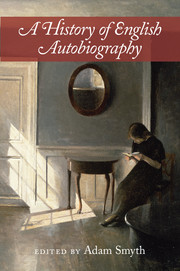Book contents
- Frontmatter
- Dedication
- Contents
- List of contributors
- 1 Introduction: The range, limits, and potentials of the form
- PART 1 AUTOBIOGRAPHY BEFORE ‘AUTOBIOGRAPHY’ (CA. 1300–1700)
- PART 2 RELIGION, GENDER, THINGS (CA. 1700–1800)
- PART 3 THE MANY NINETEENTH CENTURIES (CA. 1800–1900)
- PART 4 RELATIONAL LIVES AND FORMS OF REMEMBERING (CA. 1890–1930)
- 18 ‘Fusions and interrelations’: Family memoirs of Henry James, Edmund Gosse, and others
- 19 Queer lives: Wilde, Sackville-West, and Woolf
- 20 Anecdotal remembrance: Forms of First and Second World War life-writing
- 21 Experiments in form: Modernism and autobiography in Woolf, Eliot, Mansfield, Lawrence, Joyce, and Richardson
- 22 Psychoanalysis and autobiography
- PART 5 KINDS OF COMMUNITY (CA. 1930-CONTEMPORARY)
- Index
- References
18 - ‘Fusions and interrelations’: Family memoirs of Henry James, Edmund Gosse, and others
from PART 4 - RELATIONAL LIVES AND FORMS OF REMEMBERING (CA. 1890–1930)
Published online by Cambridge University Press: 05 March 2016
- Frontmatter
- Dedication
- Contents
- List of contributors
- 1 Introduction: The range, limits, and potentials of the form
- PART 1 AUTOBIOGRAPHY BEFORE ‘AUTOBIOGRAPHY’ (CA. 1300–1700)
- PART 2 RELIGION, GENDER, THINGS (CA. 1700–1800)
- PART 3 THE MANY NINETEENTH CENTURIES (CA. 1800–1900)
- PART 4 RELATIONAL LIVES AND FORMS OF REMEMBERING (CA. 1890–1930)
- 18 ‘Fusions and interrelations’: Family memoirs of Henry James, Edmund Gosse, and others
- 19 Queer lives: Wilde, Sackville-West, and Woolf
- 20 Anecdotal remembrance: Forms of First and Second World War life-writing
- 21 Experiments in form: Modernism and autobiography in Woolf, Eliot, Mansfield, Lawrence, Joyce, and Richardson
- 22 Psychoanalysis and autobiography
- PART 5 KINDS OF COMMUNITY (CA. 1930-CONTEMPORARY)
- Index
- References
Summary
In his essay ‘Relational Selves, Relational Lives’, Paul John Eakin discusses a range of life-writing texts: Carolyn Steedman's account of her relation to her mother in Landscape for a Good Woman: A Story of Two Lives (1986); In My Mother's House (1983) by Kim Chernin, written with her mother about ‘the conflicted mother-daughter relation across four generations’; Brothers and Keepers (1984) by John Edgar Wideman, a college professor whose brother was sentenced to life imprisonment; My Place (1987) by Sally Morgan, researching disturbing stories of her Aboriginal family history of ‘miscegenation, incest, and servitude’; and Art Spiegelman's graphic novel Maus: A Survivor's Tale (appearing in two volumes, 1986 and 1991) exploring his father's experiences in Auschwitz, and their impact on his family (Eakin 1999, 58, 59). Eakin prefaces his discussion of these narratives of troubled relationships with a very different story: a magazine profile of a twenty-three-year-old man, Christopher McCandless, found alone and dead of starvation in the Alaskan wilderness in 1992, an annotated copy of Thoreau's Walden nearby. This, for Eakin, is a story of ‘the dangerous underside of transcendental self-reliance’ (Ibid., 45); ‘the picture of a radically autonomous identity gone wrong’ (Ibid., 45). An attempt to live a life free from human relationships, it makes Eakin reassess both the first-person nature of autobiographical narration and the lives which it narrates. Hence his chapter title: ‘relational lives’, because we (all but the most extreme isolattos) live in relation to others – and hence develop ‘relational selves’; and because the lives we write are thus inescapably ‘relational lives’ too: stories of relationship rather than autonomous individuality; or at least, stories of how relationships are the conditions for individuality to be possible at all.
Eakin discusses what he calls ‘the Myth of Autonomy’, tracing feminism's critique of it as masculinist fantasy, and its positing relationality as a feminine alternative: men's life-writing seen as perpetuating the myth of the atomistic individual, as opposed to a tradition of women's writing representing the self in terms of its relations to others. But, he argues, this risks entrenching the binary opposition it seeks to undermine. What it obscures is the ways in which life-writing by men was always already relational too; but in ways our mythology of autonomous individualism stopped us from seeing.
- Type
- Chapter
- Information
- A History of English Autobiography , pp. 255 - 268Publisher: Cambridge University PressPrint publication year: 2016

